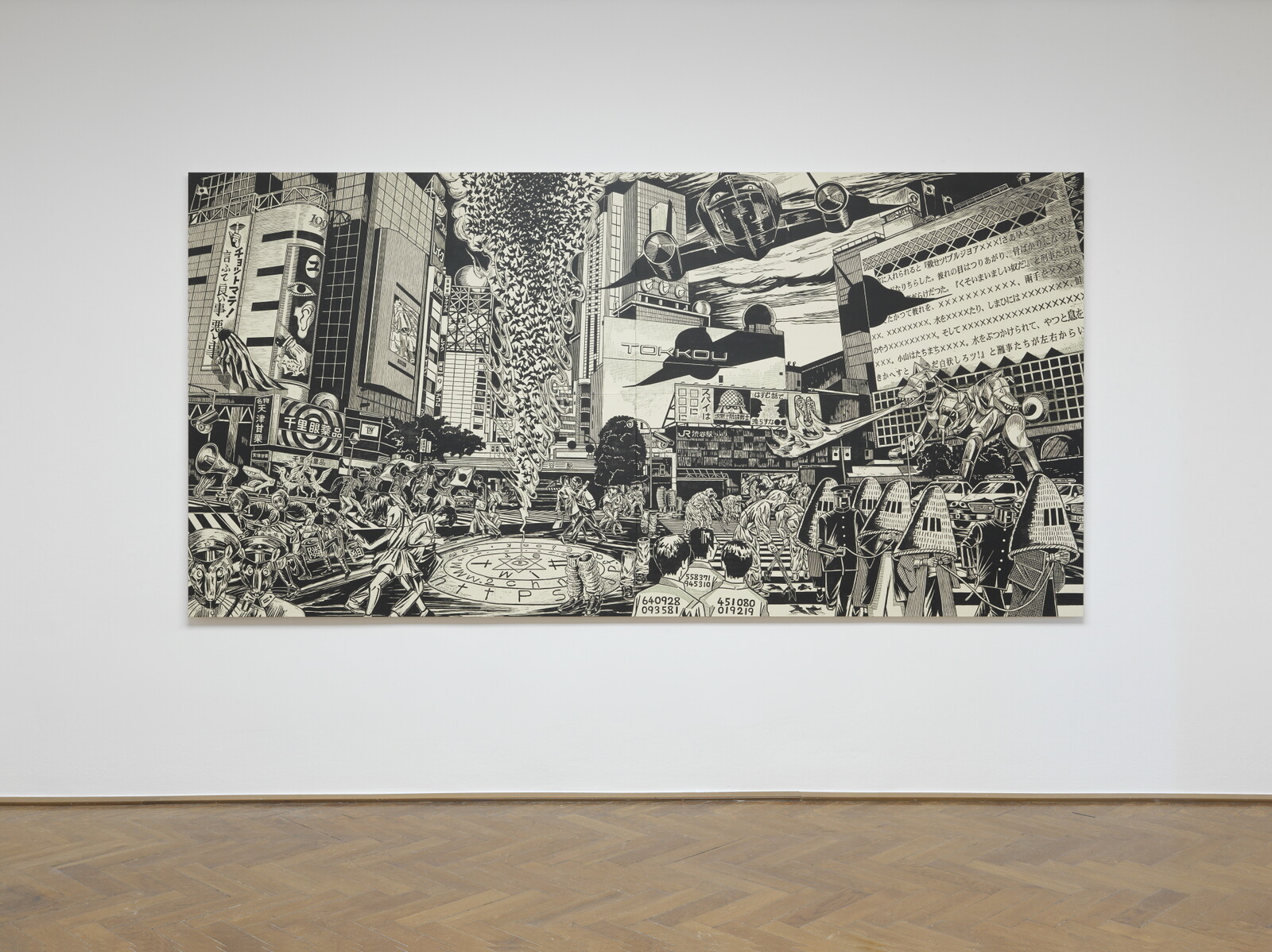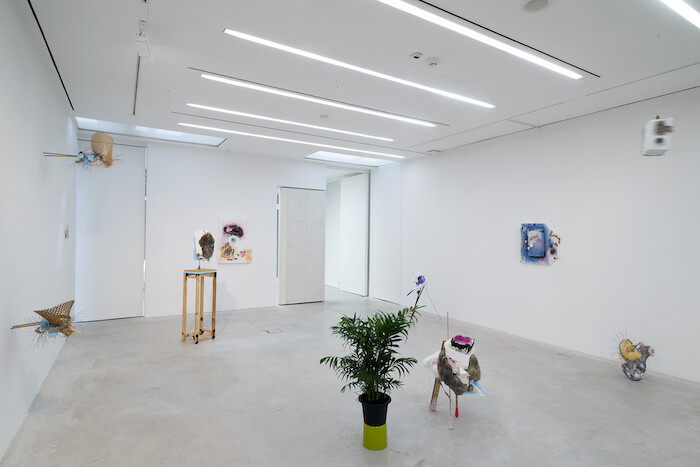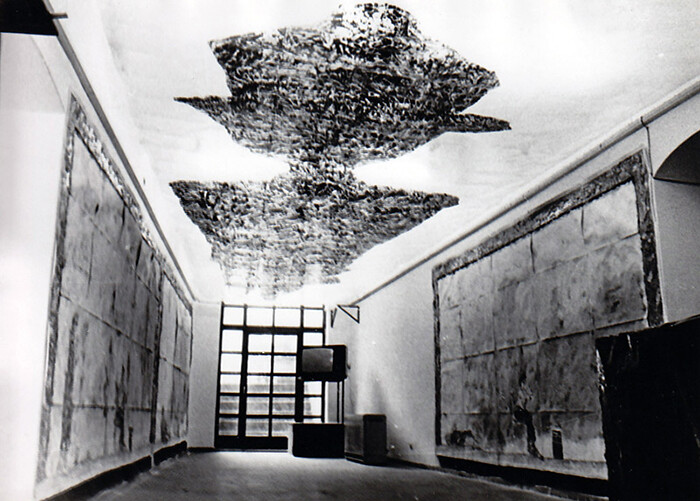Categories
Subjects
Authors
Artists
Venues
Locations
Calendar
Filter
Done
January 5, 2024 – Review
35th Ljubljana Biennale of Graphic Arts, “from the void came gifts of the cosmos”
Kate Sutton

When Ibrahim Mahama agreed to serve as artistic director of the 35th Ljubljana Biennale of Graphic Arts, he sought inspiration on a domestic scale. The simple conceptual sketch he prepared for this edition—titled “from the void came gifts of the cosmos”—shows a rudimentary bedframe, with a few unidentified objects stashed underneath. This curatorial approach attempts to reclaim an everyday architectural recess from the realm of monsters and recognize it instead as a space of potential. But dark things come from under the bed, the darkest of which may be nothing at all.
Mahama applies the metaphor of the void not only to architectural and ideological infrastructures, but also to emancipatory movements that operate within structures of colonial domination. Chief among these is the Non-Aligned Movement: a political experiment that rejected the either/or imperialism of the Cold War era in favor of a multilateral understanding of the world. Its foundations were laid at the Bandung Conference in 1955, the same year that the Ljubljana Biennale of Graphic Arts launched. Fresh from its split and subsequent rapprochement with the USSR, Yugoslavia offered a meeting ground for representatives from both sides of the Iron Curtain, and the biennial was expressly crafted to strengthen …
July 19, 2019 – Review
The 33rd Ljubljana Biennial of Graphic Arts
Tom Jeffreys

Question: How do hedgehogs have sex? Answer: very carefully.
Animals are represented at every turn across the 10 venues of the Ljubljana Biennial of Graphic Arts. In the main building, the International Centre of Graphic Arts (MGLC), vitrines contain back issues of Slovenian satirical magazine Pavliha, its pages overflowing with lions and cows, lobsters and giraffes. An owl with a quill pen sinks its hooked bill into the ear of a man in a top hat. Upstairs, Sachiko Kazama’s punningly titled large-scale woodcut print Nonhuman Crossing (2013) shows a dystopian Tokyo alive with rat-faced soldiers, birds with human legs, and humans with beaks and wings. War-Pup (2005), also by Kazama, is a group portrait of fluffy white puppies wearing gas masks. “The harshest of all voices is the voice of the ass,” says an imam in Lawrence Abu Hamdan’s film The All-Hearing (2014) about Islam and “loudspeaker libertarianism” in Cairo. The biennial’s logo is a hedgehog: its jaunty form a striking marker outside every venue.
We should not be surprised. The curatorial debut of the collective Slavs and Tatars, best known for their publishing and research projects, the 33rd edition of the biennial is an exploration of satire. With its etymological roots …
October 16, 2018 – Review
“Heavenly Beings: Neither Human nor Animal”
Alenka Gregorič

“[A]re humans able to resist together with plants and animals?” With this question, Zdenka Badovinac and Bojana Piškur invite viewers to consider the possibility that all living things can coexist—and co-resist. Most animals are so dependent on human actions and choices for their survival: they likely do not ponder ways to revolt against capitalism. Unless, like the animals in George Orwell’s Animal Farm (1945), they already have an anthem, a flag, and the Seven Commandments necessary to rise against humans. Indeed, we might imagine that animals have already elected a new species to act as leaders, and decided what position humans will occupy. But why would humans—who use animals for food, religious rituals, transport, and entertainment—be granted any position in the animals’ new world?
Several works in “Heavenly Beings” explore potential synergies between humans and animals. Maja Smrekar’s Hybrid Family (2016), for example, is a series of black-and-white photographs documenting a three-month performance during which the artist trained her body to produce breast milk, which she fed to a puppy she was living with. Correlated in content and form is Opus et domus (2018), in which Smrekar spins yarn from dog and human hair on a spinning-wheel. Broaching gender, family values, …
September 1, 2016 – Review
8th Ljubljana Triennial, “Beyond the Globe,”
Jela Krečič

In his introduction to the exhibition’s catalog, Boris Groys, the curator of this year’s edition of Ljubljana’s triennial, titled “Beyond the Globe,” refers to catastrophe movies. This pop culture allusion should come as no surprise: the destruction of the Earth by various means is mass culture’s response to the anxieties of today’s globalized world, and the goal of “Beyond the Globe” is precisely to examine how contemporary art answers to these anxieties in this world and beyond.
Connecting the exhibition’s more than 30 works, displayed mostly in Ljubljana’s Moderna Galerija, is the leitmotif of Earth and space as it manifests itself in different contexts, from Slovenia to Russia and China. The topic of outer space is surprisingly alive in the Slovenian cultural scene. The Cultural Center for European Space Technology (KSEVT) in Vitanje, for example, deals with the intersections of art, space, and science. Aktuator::MG (2016), perhaps the work most emblematic of the exhibition’s premise, was created by artists Miha Turšič, Dragan Živadinov, and Dunja Zupančič, the center’s co-founders. A tribute to the deceased actress Martina Grm, Aktuator::MG is an “art satellite” on tracks which projects abstract visuals onto surrounding walls while in motion. It’s also part of a wider project: …
December 13, 2013 – Review
IRWIN’s “Back to the USA”
Alenka Gregorič

This fall, the IRWIN collective repeated their historic “Back to the USA” exhibition at Galerija Škuc in Ljubljana, where it was first shown to the Slovenian public in 1984. This new presentation of their work brought forth information about the collective that was largely unknown to the Slovenian and international public, and demonstrated how their practice spurred new ideas and a critical debate in the contemporary Slovenian art scene. In recent years, the collective has garnered international attention for, among other projects, their 2006 East Art Map: Contemporary Art and Eastern Europe, documenting seminal works and projects taking place in the region over the last fifty years. However, in order to grasp the significance of the restaging of their “Back to the USA” exhibition in the same gallery thirty years after its initial conception, one must consider the initiative’s basic facts, concepts, and starting points, which were a direct response to the existing conditions of artistic production in Slovenia.
Artists Marko Kovačič, Dušan Mandić, Andrej Savski, Bojan Štokelj, Roman Uranjek, and Borut Vogelnik founded IRWIN in 1984; while Kovačič and Štokelj left the group early on, Miran Mohar subsequently joined and has remained a member to the present day. Within the …
